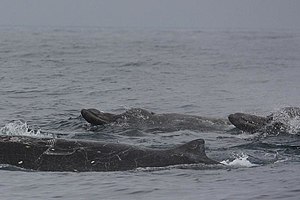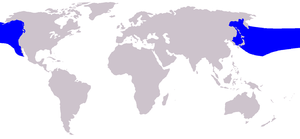Baird's beaked whale
| Baird's beaked whale Temporal range: Middle Miocene to present,
| |
|---|---|

| |
| Baird's beaked whales swimming in the ocean | |

| |
| Size compared to an average human | |
| Scientific classification | |
| Kingdom: | Animalia |
| Phylum: | Chordata |
| Class: | Mammalia |
| Order: | Artiodactyla |
| Infraorder: | Cetacea |
| Family: | Ziphiidae |
| Genus: | Berardius |
| Species: | B. bairdii
|
| Binomial name | |
| Berardius bairdii Stejneger, 1883
| |

| |
| Baird's beaked whale range | |
Baird's beaked whale (Berardius bairdii) also known as the northern giant bottlenose whale, North Pacific bottlenose whale, giant four-toothed whale, northern four-toothed whale and the North Pacific four-toothed whale is a species of whale from the genus Berardius. Baird's and Arnoux's beaked whales are so similar that researchers have debated whether or not they are simply two populations of the same species. However, genetic evidence and their wide geographical separation has led them to be classified as separate. Baird’s beaked whale is the second largest living species of toothed whale after the sperm whale.
Taxonomy
Baird's beaked whales were first described in 1883 by American zoologist Leonhard Stejneger based on a skull from a specimen that had been found stranded on the eastern shore of Bering Island the previous fall. The species was named after Spencer Fullerton Baird, the then Secretary of the Smithsonian. [3] A few months after Stejneger's description was published, Swedish zoologist August Wilhelm Malm published a description of a new species in the Beradius genus, Beradius vegae, based on a portion of a skull found on Bering Island in 1879. Beradius vegae was later determined to be a junior synonym of Beradius bairdii. [4] [5]
Description
The species reaches lengths of about 11.9 metres (39 ft) for males and 12.8 metres (42 ft) for females.[6] The snout, called a beak, is elongated and lacks all teeth except for one or two sets in the lower mandible, which are called "battle teeth" for their use in intra-species conflict. Individuals often bear scars from such confrontations.
Baird's beaked whale can live for up to 84 years.[7]
Distribution
The species occurs the North Pacific Ocean and the Japan, Okhotsk, and Bering Seas. It is a deep-water species, primarily frequenting depths between 1,000 m and 3,000 m.
References
- ^ Taylor, B.L.; Brownell Jr.; R.L. (2020). "Berardius bairdii". IUCN Red List of Threatened Species. 2020: e.T2763A50351457. doi:10.2305/IUCN.UK.2020-3.RLTS.T2763A50351457.en. Retrieved 19 November 2021.
- ^ "Appendices | CITES". cites.org. Retrieved 2022-01-14.
- ^ Stejneger, Leonhard (1883). "Contributions to the history of the Commander Islands. No. 1. Notes on the natural history, including descriptions of new cetaceans" (PDF). Proceedings of the United States National Museum: 58–89. Retrieved January 20, 2022.
- ^ True, Frederick W. (1910). "An account of the beaked whales of the family Ziphiidae in the collection of the United States National Museum, with remarks on some specimens in other American museums". Bulletin of the United States National Museum. 73 (73): 60–89. doi:10.5479/si.03629236.73.i. hdl:2027/uiug.30112106907329. Retrieved 20 January 2022.
- ^ Yamada, T.K.; Kitamura, S.; Abe, S.; Tajima, Y.; Matsuda, A.; Mead, J.G.; Matsuishi, T.F. (2019). "Description of a new species of beaked whale (Berardius) found in the North Pacific". Scientific Reports. 9 (1): 12723. Bibcode:2019NatSR...912723Y. doi:10.1038/s41598-019-46703-w. PMC 6717206. PMID 31471538.
- ^ "Berardius bairdii". fao.org. Food and Agriculture Organization of the United Nations. Retrieved 2021-07-15.
- ^ "Berardius bairdii". The Moirai - Aging Research. 2016-10-19. Archived from the original on 21 November 2016. Retrieved 2016-11-20.
Error: "Q803927" is not a valid Wikidata entity ID.
- Articles with short description
- IUCN Red List least concern species
- Articles with 'species' microformats
- Taxonbars desynced from Wikidata
- Taxonbar pages requiring a Wikidata item
- Taxonbars with invalid from parameters
- Taxonbars without secondary Wikidata taxon IDs
- Ziphiids
- Taxa named by Leonhard Stejneger
- Taxa described in 1883
- Mammals described in 1883
- All stub articles
- Cetacean stubs
